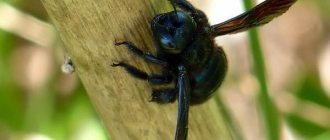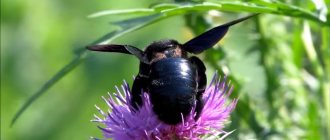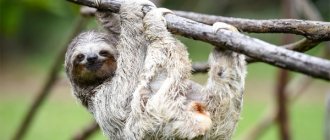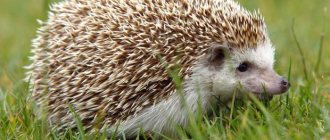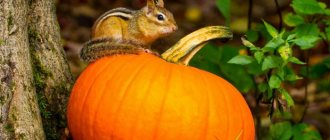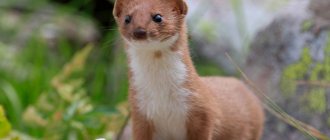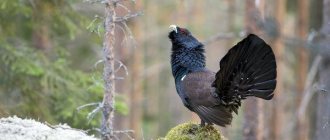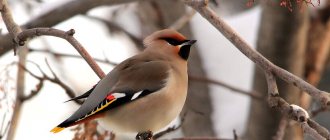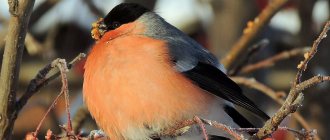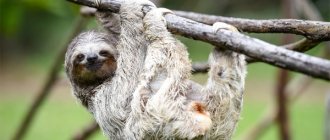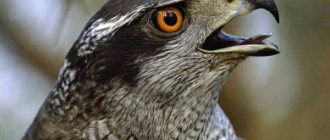The ladybug is an extremely common insect, most often having a bright spotted color. The ladybug family (Coccinellidae) includes a huge number of species - about 8000 (approximately 360 genera). Most of them are beneficial to humans because they feed on certain pests.
Ladybug, appearance of a typical representative of the family
What does it look like?
The insect has a rounded, egg-shaped body, flattened at the bottom and convex at the top.
Juveniles most often have a bright red color (but other colors also exist).
On the back of the ladybug there are black dots with a diameter of 1–2 mm. However, their number varies and depends on the type of insect.
The body size ranges from 4 mm to 1 cm (maximum). There are also flexible multi-segmented antennae and hard, expressive elytra.
Interesting fact! When flying, an insect makes an average of 85 beats per second.
Origin of the species and population
The ladybug is an arthropod insect from the order Coleoptera. This bug received its scientific name (Coccinellidae) due to the scarlet coloring of its body. There are many varieties of ladybugs, and the entire family contains more than 4,000 species.
Over the past couple of decades, the population of ladybugs has decreased amid active control of aphids. And, as a result, the little red bugs had nothing to eat.
The situation became very sad when scientists made one irreparable mistake (of course, guided by good intentions). In order to maintain the population, millions of artificially raised individuals were released into the natural environment, which, due to existing gene mutations, dramatically changed their diet, choosing their own relatives as food. This resulted in the death of a huge number of beneficial bugs, so in all European countries their populations have noticeably decreased.
What do ladybugs eat? Are they predators?
A characteristic feature of insects of the order Coleoptera is the gnawing type of mouthparts. The ladybug has similar anatomical characteristics. The structure of the digestive system begins with the mouth and ends on the abdomen with the anus. The intestinal canal runs between them. This allows the insect to consume complex molecular food with a high energy reserve when feeding.
Simply put, the coccinellid is a predator; it eats its own kind. Diet preferences are given to:
- aphids;
- spider mites;
- small caterpillars;
- eggs of butterflies, Colorado beetles;
- larvae of insect pests.
There is also a species that feeds on plant foods: pollen, flowers and leaves, mycelium, and fruits.
Varieties, their names, descriptions and photos
Below is a description of what ladybugs are, a detailed description of the most interesting varieties; You will also be able to see their photos, including close-up photos.
Point-to-point
The body length of the two-spot ladybug reaches about 5 mm. The color is dark red with two parallel black dots on the back (hence the characteristic name). The body has an oblong-oval, moderately convex shape.
The head of light-colored individuals is black, with two large irregularly shaped spots (near the eyes). Dark bugs have a completely black head.
Seven-point
The seven-spotted ladybird is one of the most common species in Europe . The body size is about 8 mm. The color is red, and there are 3 black spots on the sides. The seventh spot is located near the head.
Twelve-point
The twelve-spotted ladybird reaches 6 mm in length. It has a red or pink color. There are 6 black dots on each elytra. The insect lives primarily in North America and feeds on pollen from agricultural plants.
Thirteen-point
The thirteen-spotted ladybird has 13 spots on its surface. Color - red-brown or brick. In this case, some spots may merge with each other. The insect is common in Europe, Asia and North America.
Asian
The Asian ladybird or Harlequin reaches a length of 7 mm. It is either yellow-black or black-orange in color . The insect lives in Asia and feeds on aphids.
Note! This species is characterized by the greatest gluttony, therefore it is specially cultivated in Europe and North America to combat agricultural pests.
Ocellated
The ocellated ladybug is considered one of the largest and reaches a length of approximately 1 cm. The color is red or yellow. In this case, each of the spots is surrounded by a lighter halo. There are 20 such “eyes” on the back of the insect.
Pointless
The spotless ladybird is one of the rarest species , characterized by a complete absence of dark spots. The body of the insect is red or brown in color and covered with barely noticeable fibers. The insect reaches several millimeters in length.
Blue
The blue cow is the most unusual representative of this family. A distinctive feature of the insect is the blue color of the elytra with a characteristic metallic sheen. Dark spots on the back are absent (or simply not visible, because they merge with the dark blue color).
It lives in the eastern part of Australia, as well as in New Zealand. The insect feeds mainly on aphids. The body size does not exceed 4 mm.
Types of ladybugs
The ladybug is not necessarily red, but its coloring is in the form of dots. The dots may be absent altogether, and instead of them, stripes, patterned spots, or comma-shaped spots may appear on the shell. The most common type is the seven-spotted beetle. It lives almost throughout Europe, its dimensions reach 7 mm, the elytra are burgundy, there are two light-colored spots at the base, one dark one can be seen on the pronotum, with speckles on the elytra.
They are also divided according to the number of dots and color:
- two-spotted, usually 5mm dark scarlet individuals with 2 large black markings;
- twelve-pointed up to 6 mm, have pinkish elytra, on which 6 pieces are observed;
- thirteen-spotted up to 7mm, with brownish wings;
- fourteen-spotted - with a yellow color and black spots on them or vice versa;
- seventeen-point identical colors ranging from 2.5 to 3.5 mm;
- variable, with a black pre-back with 2 brownish spots, contrasting markings at the base of the yellowish-red elytra;
- blue ones are found on the Australian mainland and have a beautiful tint of blue and green tones;
- white or light gray - up to 15 marks, less common, like brown plain ones.
What kind of lifestyle do they lead?
Regardless of the species, ladybugs lead a solitary life, showing a bright image of individualists . These insects are collected only for procreation. They also form flocks to fly to warm places (because they don’t like the cold).
But there are also sedentary individuals who huddle together during the winter in some secluded, abandoned place (under fallen bark, tree foliage, etc.). With the onset of warmth, they leave their shelter, scattering across meadows and clearings.
Distribution area
These unique insects were able to spread across all climatic zones and are present on all continents. They cannot be found only in Antarctica and any other areas where permafrost prevails. They live in Europe and the CIS countries. Exotic species are found in Pakistan, India and South America. They live in the USA and Canada, as well as in Asian countries.
Some species like to live on plants where a colony of aphids lives. Others settle on reeds and sedges growing along rivers and other bodies of water. Finally, still others live on field plants.
Regardless of belonging to any species, these bugs prefer to lead an isolated lifestyle. They gather together only for wintering and migration, as well as during the mating season. Ladybugs are considered heat-loving insects, therefore most of the individuals that are found in temperate latitudes move to warm countries for the winter, flocking into huge flocks.
At the same time, some of them prefer to lead a sedentary lifestyle. They spend the winter huddled in huge groups of up to tens of millions of individuals. If you weigh such a mass, you can get several tons. This wintering method protects insects from unfavorable conditions.
Typically, ladybugs prefer to live under leaves, tree bark, and climb under stones. When talking about how long these beetles live, it is necessary to evaluate the conditions. If they have enough food, some individuals can live for a year or more. When there is not enough food, the lifespan can be reduced to several months.
Why is it called that?
Here are some of the versions of the origin of the name:
- In ancient times, the insect was personified with the thunder god - Perun.
The ladybug was credited with the ability to influence the weather and was perceived as a link between mortal people and the gods. - Catholics considered her a messenger of the Mother of God.
- The British associated the insect with the Virgin Mary.
But the most optimal and plausible version of why the bug was named so is that the insect secretes a poisonous white liquid (the so-called “milk”) to scare away predators. And “God’s”, probably because it helped fight aphids and other agricultural pests and did not harm humans.
Interesting fact! The Slavs considered the ladybug to be a direct messenger of the sun. Therefore, it was impossible to drive her away, much less kill her. Otherwise, you could “turn away” your luck.
What does the bright warning color mean?
It is no coincidence that the ladybug is endowed with a bright color - it helps to survive in harsh natural conditions and scares away various enemies (predatory insects, birds, etc.). This is also a kind of mimicry, like a chameleon’s ability to adapt to the color of its environment (foliage, trees, sand, etc.) for the purpose of self-preservation.
And bright colors are warning signals for the wild world, indicating the inedibility and, possibly, toxicity of a potential victim. There is even a theory in the scientific world that goes something like this: “ The brighter the color of an insect, the less likely it is to be attacked by a predator .” Therefore, the red coloring looks something like a stop sign for all sorts of enemies. However, with age, the scarlet color fades.
Where do they live?
Ladybugs can be found in almost every corner of the world, with the exception of northern latitudes (Antarctica and other polar regions).
The active period of their life activity occurs in the spring-summer period, when there are a lot of aphids and other small insects that red bugs can feast on in abundance.
As for specific habitats, they feel most comfortable in open areas with lush vegetation (lawns, clearings, forest edges, etc.). Others prefer to live in reed thickets (along water bodies). The optimal temperature for insect life should be at least +10 degrees.
Care and caution
The ladybug is small (an adult reaches an average of 0.8−1 cm) and fragile, so any attempt to pick it up or play with it can lead to negative consequences. Precautionary and careful measures when caring for a bug are the following:
- It is better to catch the animal with a net.
- In order to take an insect in your hand, you need to place your finger next to it and wait for it to climb onto it.
- The ideal temperature for life and reproduction of Coccinellidae is considered to be +20 ⁰ C, so it is recommended to avoid hypothermia.
Do not forget that your pet is an insect, so after each contact with it it is recommended to wash your hands thoroughly with soap.
What do ladybugs eat? Most are predators and eat other insects, many of which are considered serious plant pests. The ladybug is often called a gardener's best friend. They eat aphids, thereby controlling the number of insect pests in the garden and replacing the use of chemical pesticides. Ladybug larvae also feed on aphids. They also eat other insects that have soft bodies - mites, whiteflies, scale insects and others.
How and where do they winter?
As mentioned earlier, with the onset of autumn, some insects cluster in large groups, each of which numbers up to a million individuals. Initially, they look for secluded places (wood, dry leaves, stones, abandoned buildings, etc.), then they move there and wait for the arrival of spring. Other species, on the contrary, prefer to leave their usual habitats for the winter, flying like birds to the southern corners of the planet.
Attention! If you find “sleepy colonies” of insects, you should not disturb them. If they are somehow in the way (for example, they are in a barn, bathhouse, or some other place that will be used in the future for household needs), you need to carefully put them in a jar and move them to a comfortable place where they can safely spend the winter .
How do they reproduce, are born and develop?
Insects reach sexual maturity at approximately 3–6 months of life (depending on the species).
Their mating season begins with the arrival of spring. The female produces a characteristic odor, thanks to which the future chosen one finds her. Next, mating occurs, and the female lays eggs (most often near colonies of parasites to provide food for the offspring).
The eggs are oval in shape with slightly tapered ends. Color - yellow-orange. In one clutch, the female manages to lay about 400 eggs . After 1–2 weeks, the larvae are born.
The ladybug goes through the following stages of development:
- larva remains in this state for 1–2 months.
- The pupa attaches itself to the grass and spends 7–10 days in this position. It is during this period that the necessary parts of the body are formed.
- An adult lives from several months to 1–2 years.
Reproduction of ladybugs
Ladybugs reproduce several times a year, in spring or autumn. In temperate latitudes this is the beginning of May. The female becomes sexually mature at the age of 3-6 months. As a rule, after a cold period, she is able to emit a pungent odor that attracts males.
The female places eggs on vegetation with an abundance of aphids, providing food for future offspring in advance. They have an elongated shape, narrowed towards the end, and are colored yellowish-orange. One clutch can number from several to 400 pieces, arranged in even rows, close to each other. Sometimes they can be eaten by their own relatives, the so-called cannibal larvae.
All about the benefits and harm
- The benefit of ladybugs is that they eat large quantities of parasites - pests of agricultural land. Therefore, they are specially bred at enterprises for the appropriate purpose.
- Herbivorous species of these insects can cause harm to humans , causing irreparable damage to agricultural crops (in particular potatoes, cucumbers, tomatoes and sugar beets). But most of these species live exclusively in tropical countries.
Nutrition and maintenance
In order to feed a ladybug, you need to know what it eats. Young individuals are very voracious. Ladybugs eat:
- aphids are the main source of food;
- psyllids;
- scale insects;
- scale insects;
- ticks.
Therefore, they can most often be found under the leaves of trees and plants, as well as in crevices of buildings and wooden window blocks.
Transparent glass or plastic containers with a closed top are ideal for home improvement. The best option would be a bottle or food box with a lid. But we should not forget that every living organism requires oxygen for life and development, so small holes must be made in the lid to allow air to enter the container.
The cow's home should be of such a size that it can fly short distances. A twig or any object with an internal hole is perfect as a sleeping place so that the animal can hide there. For variety and beauty, you can add flower petals or grass to the “interior”. It is important to prevent the leaves from rotting and drying in the container.
, changing them every two days.
Food for keeping ladybugs at home can be:
- sugar;
- lettuce;
- raisin;
- apples.
Ideas for a summer residence that give a second life to a washing machine
Water plays a special role in the nutritional diet of any organism. For convenience, you can place a metal bottle cap in your home and fill it with water. The water level in the drinking bowl should not exceed the height of the beetle's body so that it does not drown. It is enough to feed and water the insect 2-3 times a day, but it is important not to overfeed it. Meals should be taken in small portions.
Interesting Facts
Here are some interesting facts about ladybugs:
- In ancient times, people were able to predict the weather with the help of red bugs.
So, if a cow quickly flew away from the palm, this foreshadowed bright and sunny weather in the future. If, on the contrary, the insect did not fly away anywhere and continued to sit on the hand, rain and thunderstorms were expected.
- In many countries, ladybugs are considered a symbol of good luck, so they should never be harmed. Otherwise, you can bring trouble on yourself and your family.
- Scientists still cannot solve the mystery of how ladybugs return each time after migrating to the same places where they lived in the warm season.
- At the beginning of the 19th century, in many European countries and the United States, specially trained people tracked the wintering sites of ladybugs and collected them in bags. In the spring, insects were released into the fields.
In this video, interesting facts about ladybugs will be presented in a fascinating and knowledgeable way, which may surprise someone and help to better “understand” these little red bugs.
LiveInternetLiveInternet
Ladybugs are small insects well known for their bright colors and lack of fear of humans.
Most people are familiar with the seven-spotted ladybug, but the species diversity of these insects is enormous. There are 5,200 species of ladybugs in the world, classified into the family of the same name in the order Coleoptera. Thus, numerous species of beetles are relatives of ladybugs.
Seven-spotted ladybug (Coccinella septempunctata). Ladybugs are small in size, reaching 4-9 mm in length. They are characterized by a very small head, an enlarged cephalothorax and a rounded or slightly elongated body with hard convex elytra. The color of most species is very bright - red with black dots, the number of which in different species can vary from 2 to 22. At the same time, among ladybugs there are species with orange and yellow elytra, with dots not only black, but also white. For example, the fairly common two-spotted ladybug is highly variable in color. The blue ladybug (Halmus chalybeus) has elytra with a bright metallic sheen. In some individuals it is red with black dots, in others these dots have turned into irregularly shaped spots, in others the color seems to be inverted - black with red spots. Less common among ladybugs are monochromatic black species.
Ladybugs are distributed throughout the world and are found on every continent except Antarctica. These beetles inhabit open spaces with herbaceous vegetation - meadows, forest edges, gardens, steppes, and less often dense forests. They live alone, forming aggregations only during wintering. Ladybugs usually crawl along plant stems in search of food, but they also willingly fly over long distances.
Their flight is light, fast and completely silent. Species of the temperate zone fall into torpor in the winter; for this they form clusters in the fall and hide under stones or in foliage.
Ladybug in flight. The vast majority of ladybugs are voracious predators and only a few species are herbivorous. Herbivorous ladybugs feed on a narrow range of plants; for example, the ladybird epilyachna argus eats exclusively the leaves of Bryonia dioeciousa (steppet). Predatory ladybugs are extremely voracious and can eat up to hundreds of small insects per day - aphids, spider mites, scale insects, whiteflies, and they prey not only on adult individuals, but also eat their larvae and eggs. Occasionally, ladybugs can even attack butterfly caterpillars. The victims of ladybugs are inactive, so hunting for them comes down to simply eating the victim.
The seven-spotted ladybug eats aphids. Ladybugs breed several times a year; species from the temperate zone begin breeding in May. The female lays small yellow eggs on the stems or undersides of leaves. Females of different species can lay from 200-400 to 1500 eggs.
The two-spotted ladybug (Adalia bipunctata) lays eggs. Ladybugs try to lay eggs near clusters of victims (aphids), and the rhodolia ladybug directly on the egg sacs of its victim - the mealybug. Thus, the larvae of ladybirds are provided with food from the first minutes of life, however, finding food for them is not difficult, since the larvae are mobile and run quickly. The larvae are small, with an elongated, segmented body; some species may have branched outgrowths. The color of the larvae is gray (less often yellow) with yellow or red dots. The larvae are as voracious as their parents and can even attack prey that is larger than them. Their development lasts from 2-4 weeks to 3 months, during which time each larva can eat up to 1000 aphids.
Larva of eighteen-spot myrrha (Myrrha octodecimguttata). Ladybugs themselves have few enemies. Of course, they get in the way of birds, but they have an effective means of defense. From the joint of the legs they secrete a pungent yellow liquid with an unpleasant taste, so birds and lizards more often spit out the caught bug than eat it.
Harmony ladybug (Harmonia axyridis) is an unusual yellow color. Among these beetles, only the herbivorous potato and melon beetles (inhabiting the Far East and Central Asia, respectively) can cause damage to cultivated plants. Other predatory species bring undoubted benefits to humans, destroying a huge number of harmful insects. That is why ladybugs have been respected and loved by people since ancient times. Among all nations, these bugs were considered a symbol of goodness, prosperity, and gullibility.
Interestingly, in 55 world languages there are 329 names for these insects, one way or another connected with the concept of God! These insects are called “ladybugs”, “lady sheep”, “lady cattle”, etc. The English name (literally translated "Virgin bird") refers to the Virgin Mary. And this connection arose thanks to seven points on the back of the most common species - the seven-pointed ladybug.
The British interpreted the red color of the ladybug as a reminder of the passion of Christ, and seven black dots were associated with the seven sorrows of the Mother of God. Ladybugs have been a favorite object of children's folklore, because they willingly land on hands and clothes, and are accessible to observation even by the smallest naturalists.
The larva of the herbivorous Epilachna argus eats a Bryonia leaf. Now these peaceful and beautiful beetles continue to serve people. Ladybugs are used on an industrial scale to control pests of agricultural crops: rhodolia - to destroy the Australian grooved bug on citrus plantations, and the Lindora ladybird - to destroy scale insects in orchards.
Source
FANINA
Security
The ladybug is already listed in the Red Book in many countries, including Russia.
If this insect completely disappears, humanity will face an imbalance in nature and the active proliferation of dangerous pests, which will have to be destroyed chemically.
Therefore, today ladybugs are successfully bred in laboratory conditions , and then released into the fields. But in order to maintain balance, it is necessary to abandon the chemical destruction of aphids and direct general efforts to improve the ecological situation of the environment.
Ladybugs are amazing creatures of nature that bring great benefits to people (with the exception of herbivorous species). They protect crops from various kinds of parasites, thereby preserving the harvest and allowing humanity to do without chemicals. However, in recent years the number of these beneficial insects has noticeably decreased, so they are listed in the Red Book and attempts are being made to restore the population artificially.
